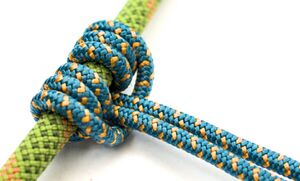Prusik knot
Prusik knot (technically a hitch) is a very versatile hitch used in abseiling, pulley systems, prusiking up the ropes. In some of the applications it can be replaced by tibloc and various traxions and similar devices which provides improved comfort of use by unidirectionally moving seamlessly on the rope while providing the same stopping functionality as prusik.
| Prusik knot | |
|---|---|
 | |
| Other names | Prusik, prusik hitch |
| Use(s) | abseiling, advanced rope techniques including (self-)rescue techniques |
| Pros | Fast, clean, just an accessory cord or a sling needed |
| Cons | Compared to traxion, tiblocs and such it is a bit tedious to get loosen in some cases and it must be moved actively |
| Category | Hitch |
| Strength | ~5-8 kN when a 5-7mm accessory cord is used[1] |
Tying
Number of loops varies based on required amount of friction.
Diameter recommendations
this section is not yet inspected thoroughly, statements might be incorrect and/or misleading!
Based on the cord load limits, 5 mm (5.1 kN) and 6 mm (10 kN) reep cords are generally recommended for tying prusiks.[2] General rule of a thumb is that to ensure reliable blocking, prusik cord should have roughly 1/2 of a diameter of the rope on which the prusik is tied on. For a standard climbing rope (~9.7 mm), the slightly-above-recommendation 6 mm cord has the advantage that it is easier to loosen and the loading limit of the cord is substantially higher than in case of the 5 mm cord. However, in some rope-prusik combinations, it might not block readily enough. In some cases, 5 mm prusik is hard to loosen under and after load. Both for 5 mm and 6 mm cord, testing in safe environment is highly recommended.
References
- ↑ Jenks, Ryan (16 June 2021). Prusik, Auto Blocks, and Klemheist Break Tests. HowNOT2. Retrieved 16 August 2025.
- ↑ LANEX a.s. "Acessory cords". tendon.cz. LANEX a.s. Retrieved 16 August 2025.